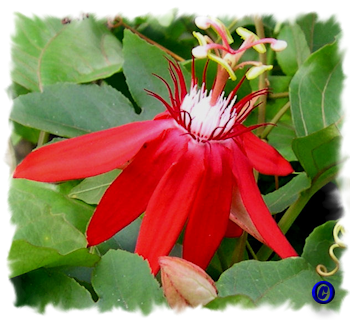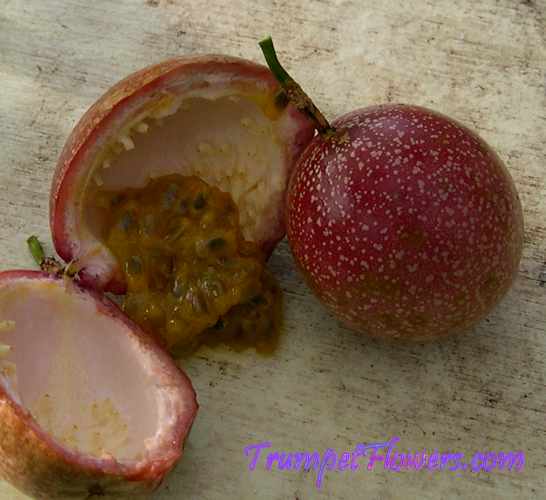Grow
Passionflowers
Passionflowers
 Passiflora is a breathtaking genus of plants, with most fruits deliciously edible. The unusual flowers are the big attractant though, with finely detailed corona filaments and tall, stand above anthers and long petals, passion flowers are truly beautiful flowers worthy of collecting.
Passiflora is a breathtaking genus of plants, with most fruits deliciously edible. The unusual flowers are the big attractant though, with finely detailed corona filaments and tall, stand above anthers and long petals, passion flowers are truly beautiful flowers worthy of collecting.
Most passion flowers are surprisingly easy to care for. The plant will insist upon a fast, well draining soil. If the soil is too heavy and keeps water around their roots for extended periods of time, the plant will develop root rot and slowly die. For this reason, don't over water the plant. Allow the pot to dry out thoroughly before deeply watering.Most species and cultivars of passiflora can be planted in the ground in zones 9 through 11. Zones 8 and lower, you can easily place passiflora is containers and allow them to twine themselves up a trellis or the side of a patio or other wall. Cut them harshly back in the fall, a week or so before the first frost; and bring inside to a basement or garage that stays above freezing. Water only monthly during this resting period. If the plant continues to grow, go ahead and keep cutting it back.
In spring, whether in ground or a pot, begin a fertilizing routine every 3 months. Make sure you weaken the fertilizer by 3, as passiflora does not really care for an abundance of fertilizer. Potassium is the most needed of the 3, so make it the higher number when you buy your fertilizer.
 If you do have your passion flower potted, take note that it does like to be slightly root∼bound. If you think it's time to move up a pot size, make sure the plant is completely pot∼bound before removing it. Move up by only a two inch size pot, so it will fill it in quickly and continue to grow on top.Passiflora species can grow in full sun to dappled sunlight, depending upon which one you have. Most like full sunlight in mornings and early afternoons, but intense, hot late afternoon towards evening sun can burn their leaves and slow growth. Some cultivars, like suberosa; like dappled sunlight instead of any strong sunlight. Knowing the history of your passiflora and where it originated will help you determine what type of lighting to give your plant.
If you do have your passion flower potted, take note that it does like to be slightly root∼bound. If you think it's time to move up a pot size, make sure the plant is completely pot∼bound before removing it. Move up by only a two inch size pot, so it will fill it in quickly and continue to grow on top.Passiflora species can grow in full sun to dappled sunlight, depending upon which one you have. Most like full sunlight in mornings and early afternoons, but intense, hot late afternoon towards evening sun can burn their leaves and slow growth. Some cultivars, like suberosa; like dappled sunlight instead of any strong sunlight. Knowing the history of your passiflora and where it originated will help you determine what type of lighting to give your plant.
Passionflower fruits are delicious, and most are edible. I prefer passiflora incarnata and passionflower edulis for edible fruit. Passiflora suberosa, as an example, have fruits so tiny they are worthless for eating, but still good for getting seeds to try and sprout. Passionflower foetida also has small fruits, but are bigger than suberosa, and are said to be tasty.
A good potting mix for passion flower includes 10 equally divided parts. a rich loam based organic material in 2 parts, 2 parts coarse sand, 1 part compost, 3 parts peat and 2 parts perlite.
Passiflora that you have grown from seed can tolerate slight changes much better than passion flower that is already grown out and potted when you receive. Seed grown passions can be watered and fertilized a bit more frequently, and will tolerate lighting changes more than potted passion plants that have adapted to a pre~exsisting environment.
During the growing season, keep passion flower vines cut back to a reasonable size. A healthy passiflora will tend to take over whatever is nearby, it's tendrils grasping anything it can. It will also force the plant to bloom quicker and give larger flushes.
Note: Some passiflora will not bloom for a few years. Some never bloom at all, but that is fairly rare. In most cases, seed grown passiflora bloom within 2 years of germination. Passiflora foetida usually flowers within 6 months of the first year.Passion flower vines typical lifespan is between 10 and 15 years. That's a good lifespan, considering you can take cuttings inbetween and create more plants, and make seeds and seed crosses.
Tags: grow passionflowers, grow Passionflowers, passiflora, passionflower lifespan, passionflowers from seeds,


